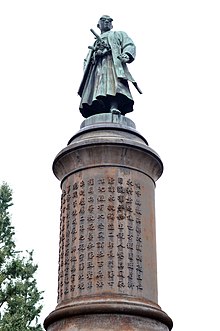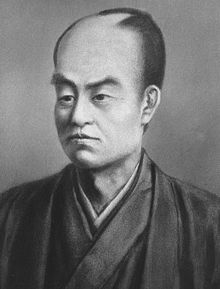Ōmura Masujirō

Ōmura Masujirō ( Japanese. 大村 益 次郎 ; * May 30, 1824 ; † December 7, 1869 ) was a Japanese military leader and military expert who is regarded as the founder of the Imperial Japanese Army .
Ōmura came from a village in Suō Province (today the city of Yamaguchi in Yamaguchi Prefecture ). He was interested in western studies ( Rangaku ) at an early stage , and especially in western medicine. He was sent through the fiefdom of Chōshū to study at the Tekijuku in Osaka under Ogata Kōan , later under Philipp Franz von Siebold in Nagasaki .
In 1853 he was hired by the Uwajima fief (today's Ehime Prefecture ) as a military instructor , and from 1857 he taught at the Shogunate's military academy, the Kobusho in Edo .
In 1862 he was called back to Chōshū to teach at the local military academy and to reform their army. He gained a reputation as a brilliant tactician when he put to flight the forces of the Tokugawa Shogunate , who had been sent against Chōshū in 1866. He distinguished himself further in the campaigns of the Boshin War against the Shogun .
After the Meiji Restoration , he became Vice Minister for Military Affairs. As such, he caused controversy with a proposal for general conscription , as this would result in the end of the samurai class .
In October 1869 he was attacked and seriously injured in Kyoto by a group of dissatisfied ex-samurai. He died of his injuries a few weeks later. However, his proposals to create a modern Western-style army were carried on by his protégé, Yamagata Aritomo .
Ōmura is honored with a large bronze statue, the first in Japan in the western style, in the middle of the ceremonial route to the Yasukuni Shrine in Tokyo .
See also
literature
- Akamatsu, Paul: Meiji 1868: Revolution and Counter-Revolution in Japan. Trans. Miriam Kochan. New York: Harper & Row, 1972.
- Beasley, WG: The Meiji Restoration. Stanford: Stanford University Press, 1972.
- Beasley, WG: The Rise of Modern Japan: Political, Economic and Social Change Since 1850. St. Martin's Press, New York 1995.
- Craig, Albert M .: Chōshū in the Meiji Restoration. Cambridge: Harvard University Press, 1961.
- Jansen, Marius B. and Gilbert Rozman (eds.): Japan in Transition: From Tokugawa to Meiji. Princeton: Princeton University Press, 1986.
Web links
| personal data | |
|---|---|
| SURNAME | Ōmura, Masujirō |
| ALTERNATIVE NAMES | 大村 益 次郎 (Japanese) |
| BRIEF DESCRIPTION | Japanese military leader and military expert |
| DATE OF BIRTH | May 30, 1824 |
| DATE OF DEATH | December 7, 1869 |
